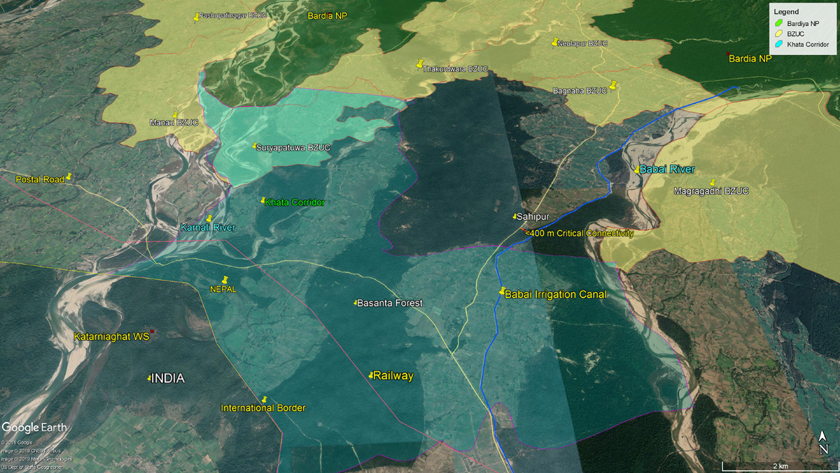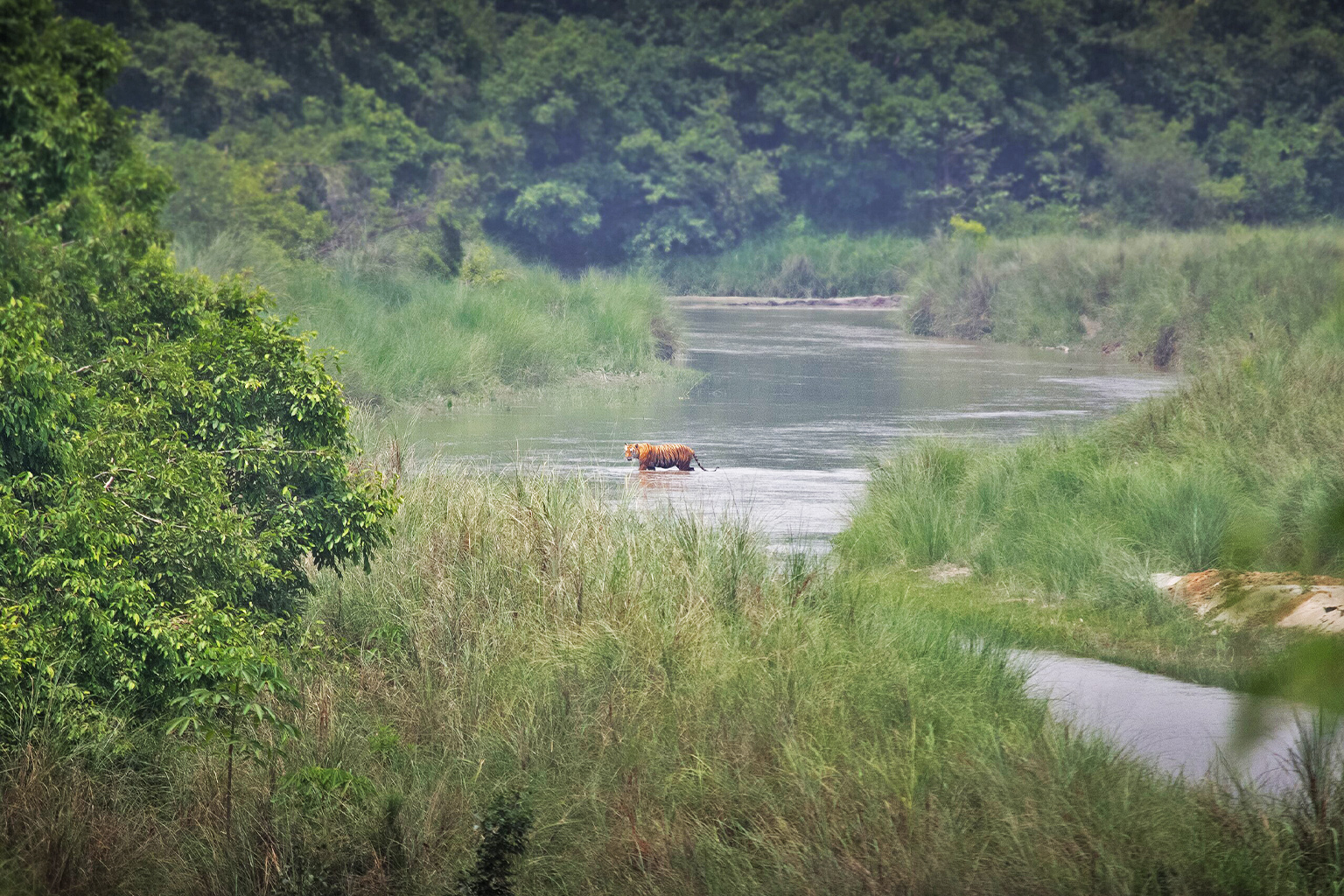
Tyger! Tiger! Burning bright
In the forests of the night
–William Blake
Poet William Blake symbolically depicts and immortalises the tiger as an awe-inspiring creature in his poem “The Tyger”. The very image of a tiger creates a feeling of fear and respect for the majestic animal. It has no known predator and is at the top of the food chain.
Conservationists often refer to the tiger as a “keystone” or “flagship” species. It is because a healthy tiger population indicates the good health of the related ecosystem. It also reflects a good prey base and habitat for the wild animals it preys on. It is said the big cat needs 200-250 kg of flesh in a week to sustain.
Royal Bengal tiger
The Royal Bengal tiger (Panthera tigris tigris) found in Nepal’s lowland forests, northern India, Bhutan, and Bangladesh is one of the five remaining species of tiger found in the world today. The vast forests in the southern plains of the country were once a safe haven for the animal. Royalties from India and abroad used to come here to hunt tiger for the trophy. Such extended hunting expeditions, however, had hardly any impact on the abundant tiger population of the time.

Degradation and fragmentation of tiger habitat
Following the eradication of malaria in the country in the late 1950s, there was a large scale migration of hill people from the mid-hills to the fertile land of the southern plains. In the ensuing years and decades, there was unchecked deforestation for agricultural and infrastructure development.
Rapidly growing human population coupled with subsistence agricultural practices not only degraded the prime tiger habitat there but also relegated the alarmingly dwindled tiger population to the confines of the wildlife sanctuaries and adjoining forests.
Despite the subsequent conservation measures, this magnificent animal is highly endangered and still faced with the threat of extinction. Elsewhere, Balinese and Caspian tigers are already extinct, whereas the Javan tiger is believed to have disappeared in the 1980s.
Challenges of Tiger Conservation
The major challenges of tiger conservation include habitat loss due to burgeoning human population, poaching and illegal trade in its body parts. Local people who live on the fringe of forested areas depend heavily on forest resources such as firewood and fodder. The cattle they rear also need grazing ground. All these human-induced activities exerted tremendous pressure on the forests, further shrinking the remaining wildlife habitats.
Local people and their cattle, however, have been traditionally using forest products for sustenance. The big question is why should a poor local inhabitant who does not know where his next meal is going to come from care for tiger conservation?
Man-wildlife conflict
The interface between man and some wild animals is certain to trigger conflict. Such conflict between local communities living around the protected areas and wildlife occur when herbivores damage crop in the adjoining crop field or tigers kill their domestic animal. Despite the legal provision of a hefty fine or a sentence of up to 15 years in jail or both for killing a tiger as well as a compensation scheme for crop or livestock damage, affected locals are sometimes known to resort to retaliatory killings.
Tigers are elusive and avoid humans. Unfortunately, sometimes human life is lost in a tragic encounter between the two. There are also instances of affected locals killing a tiger by putting poison on its kill. In other words, a tiger could be killed without firing a single shot.
Trained park technicians capture problem tigers by darting and immobilizing them and then send them to the enclosures at Chitwan or Bardia national park, or to the central zoo in Kathmandu. A compensation of NRs, 10 lakh is paid for the loss of life in a tiger attack. Likewise, up to NRs. 2 lakh is compensated for injuries sustained in such an attack.
Tiger poaching and illegal trade in its body parts
Increasing international demand for tiger skin and bone has fuelled illegal trade in its body parts, thereby threatening the long-term survival of this endangered wildlife. Tiger bone is used in some oriental traditional medicine for its so-called aphrodisiac properties.
Being one of the tiger range countries, Nepal is considered both a source (country) and a transit point. In tandem with stringent international action, Nepal’s legislation regards wildlife crime as organized crime and prohibits trade in tiger parts in and out of the country.
Despite the country’s commitment to curb wildlife crime together with the success achieved over the years in minimizing poaching and illegal trade in tiger parts, opportunistic poaching still remains a problem. In the past decade, 49 tiger skin and 204 kg of tiger bones were seized, while 2,258 people were arrested in connection with their involvement in the wildlife-related crime. Illegal dealers in wildlife trade are known to exploit the ignorance of vulnerable community members and lure them into providing information on wildlife movement and assisting them in poaching. As long as there is a demand for tiger parts in consumer countries, Nepal will face the threat of tiger poaching. In most of the aforesaid cases, the perceived benefit appears to outweigh the consequences of involvement in wildlife crime.

Tiger conservation efforts
The first tiger conservation initiative could be traced back to 1972, when the government of Nepal, WWF-US and the Smithsonian Institute jointly launched the Tiger Ecology Project in Chitwan. This project raised the issue of the importance of tiger conservation along with the need to secure its prey base and natural habitat. This issue eventually found its place on the national agenda.

The early conservation emphasis was focused on species preservation and adherence to strict law enforcement practices. The units of Nepal Army stationed in national parks and wildlife reserves were initially intended to serve as a deterrent to illegal activities. Members of the units deployed there play an important role in regular patrolling in core areas, while also complementing in anti-poaching initiatives.
A growing number of human populations living around the protected areas have been exerting pressure on forest resources of the adjoining and adjacent forests for a long time. Apart from the eventual park-people conflict on the fringe of forested areas, the lesson learned over the years was that a more conciliatory approach was needed to win the support of local people for the long-term survival of this marvel of nature, now confined to the island-like wildlife sanctuaries.
Subsequently, the government established buffer zones around the country’s national parks and wildlife reserves with the objective of making local communities self-reliant on forest products through community forestry, while also creating opportunities for sources of livelihood for them. Moreover, a legal provision has also been made to plough back a major slice of the revenue earned there through eco-tourism to buffer zone development activities.
Success story
Nepal’s commitment to tiger conservation is eventually yielding results. The tiger count conducted in 2018 has recorded 235 tigers in the wild. The earlier census of 2009 had recorded 121 individuals. The result shows the country is close to doubling its tiger population and achieving the global commitment made in the 2010 St. Petersburg Summit in Russia.
Tiger count is conducted through the animal’s unique stripe patterns by using the camera trap method.
The said success in tiger conservation is the result of the concerted efforts of government agencies, conservation organisations, donors and community-based organisations.
Local stewardship
As a leading conservation organisation, WWF Nepal has joined hands and worked with the government of Nepal for over two decades. Its early focus on species-centred conservation work has evolved to more integrated conservation activities–from income-generating activities for local inhabitants to winning their support in conserving endangered wildlife including the Bengal tiger. The mobilisation of local people in tiger conservation has helped in reducing wildlife poaching.
Apart from providing support for community forestry in the degraded forest patches outside the protected areas, the conservation organisation’s other important work is relating to the initiation of the anti-poaching drive with an informants’ network. This approach is fully justified as poaching is often said to happen not in the core areas but outside it–in the buffer zone and adjoining national forests. Community involvement in conservation is gradually showing positive signs as Nepal has witnessed zero-poaching (of rhinoceros) year several times.

The Terai Arc Landscape
The conservation lesson learned over the years is that protecting tiger in the existing protected areas alone will not ensure its long-term survival. In other words, tiger habitat needs to be extended beyond the confines of these sanctuaries. For this reason, the government and WWF have jointly launched the Terai Arc Landscape (TAL) Program in 2001. This landscape-level approach in conservation aims to secure a larger area for tiger conservation by building connectivity between adjacent protected areas and adjoining forests within the country as well as between the forests of the trans-border areas of Nepal and India with biological corridors to facilitate dispersal of this endangered species.

The community forestry program in the degraded patches of forests in TAL has not only helped in the regeneration of forests but also in wildlife movement. Mega terrestrial wildlife such as the wild Asian elephant (Elephas maximus) and the Greater one-horned rhinoceros (Rhinoceros unicornis) have been sighted in the corridor forests. Moreover, the tiger movement has been recorded in the Khata corridor which provides connectivity between Nepal’s Bardia National Park and the Katarniaghat Wildlife Sanctuary of India.
The way forward
Experts say national effort alone will not be enough to deal with the nexus of illegal dealers in international trade in tiger parts and that tiger range countries need to meet regularly to address this thorny issue. Nepal has already initiated talks on the matter with neighbouring countries. Since both Nepal and India are tiger range countries and there are contiguous forests in some parts of the trans-border areas, the TAL program has been organising periodic meetings between the conservationists of the two countries to deal with wildlife crime and illegal trade in the trans-border areas. The ongoing efforts of governmental agencies, conservation organisations, committed conservationists, donors, and local people give us reason to feel optimistic about the future of the endangered species.
From the archive.























